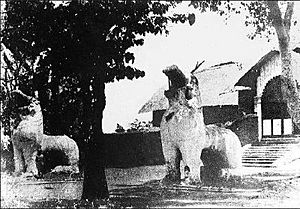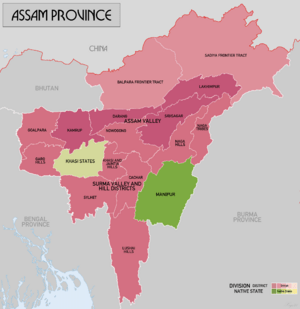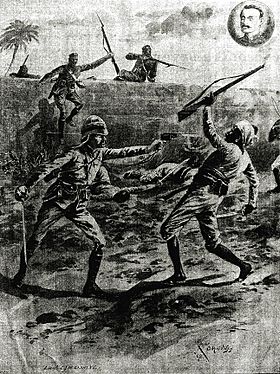Anglo-Manipur War facts for kids
Quick facts for kids Manipuri Rebellion of 1891 |
|||||||
|---|---|---|---|---|---|---|---|
 The sculptures of two dragons in front of the Kangla Palace were destroyed during the war. |
|||||||
|
|||||||
| Belligerents | |||||||
| Commanders and leaders | |||||||
| Strength | |||||||
| +395 2 guns |
+3,200 2 guns |
||||||
| Casualties and losses | |||||||
| 4 † 15 (WIA) |
+178 † 5 |
||||||
The Anglo-Manipur War was a short fight between the British and the royal family of Manipur Kingdom. Manipur was a princely state, meaning it was ruled by its own king but was also connected to the British Empire in India.
The war started when a powerful general in Manipur, named Tikendrajit, took over the palace. He removed the king and put his half-brother in charge. The British government did not like this. They tried to arrest the general, but it failed. Instead, Manipuri forces attacked the British home (residency) there. The British official and others were killed.
Because of this, the British sent soldiers to Manipur. The fighting lasted from March 31 to April 27, 1891. The general and other leaders were arrested. The British then took control of Manipur. They ruled it as a princely state until 1947, when India became independent.
Contents
How the War Started
In an earlier war, the British helped Prince Gambhir Singh get his kingdom of Manipur back from the Burmese. After that, Manipur became a British protectorate. This meant the British protected Manipur and had some influence there. From 1835, a British official called a Political Agent lived in Manipur.
In 1890, Surachandra Singh was the Maharaja (king) of Manipur. His brother, Kulachandra Singh, was the jubraj (the next in line to be king). Another brother, Tikendrajit Singh, was the senapati (the military commander or general). The British Political Agent at the time was Frank Grimwood.
Tikendrajit was known as a very capable leader. He was also friendly with the British Political Agent. However, some historians say that Tikendrajit started to question how helpful the British were. This was because the British had stopped giving military help to Manipur in the 1880s.
Also, the British had taken over a nearby area called Upper Burma. This made Manipur less important to them for military reasons. The British wanted to make changes to how Manipur was run. But Tikendrajit seemed to stand in their way.
The British thought Tikendrajit was stopping their influence in Manipur. They saw him as a threat. They even accused him of taking too much power and making the king a puppet. They also said he treated the Manipuri people badly. The British wanted Tikendrajit removed from Manipur. In 1888, they told Maharaja Surachandra to remove him, but the king refused.
Later, Maharaja Surachandra went to the British Residency. He signed a paper saying he would give up his throne. He then went to British territory. But once he was safe, he changed his mind. He wanted to be king again. Both the Political Agent and a higher British official, James Wallace Quinton, told him not to go back.
Palace Takeover and British Response
On September 21, 1890, Tikendrajit Singh led a takeover of the palace. He removed Maharaja Surachandra Singh. He then made Kulachandra Singh the new ruler. Tikendrajit also declared himself the new jubraj. Maharaja Surachandra Singh went to the British Residency for safety. Grimwood helped him escape the state.
Maharaja Surachandra Singh went to Calcutta to ask the British government for help. He reminded them of how he had helped them in the past. The British official Quinton convinced the government not to put the Maharaja back on the throne. But they still wanted Tikendrajit Singh to be punished.
Quinton arrived in Manipur on March 22, 1891. He brought 400 Gurkha soldiers led by Colonel Skene. The plan was to have a meeting (called a Darbar) at the British Residency. The new ruler, Kulachandra Singh, and other important people were supposed to attend. At this meeting, the British would demand that Tikendrajit surrender.
Kulachandra Singh came to the meeting, but Tikendrajit did not. Another attempt was made the next day, but it also failed. Quinton then ordered his soldiers to arrest Tikendrajit in his fort. But the Manipuri forces fought back. The British Residency itself was surrounded.
Finally, Quinton went to talk with Tikendrajit. Grimwood, Skene, and other British officers went with him. The talks did not go well. As they were leaving, an angry crowd attacked the British group. Grimwood was killed with a spear. The others escaped back to the fort. But later that night, the crowd led them out and killed them, including Quinton.
The remaining British soldiers in the Residency were led out by two young officers. Frank Grimwood's wife, Ethel Grimwood, was also with them. It was a messy escape. But they met a rescue group in the forests and were saved. The Residency was set on fire soon after they left.
Ethel Grimwood was the only woman in the group that escaped. When she returned to Britain, she was seen as a hero. She received a medal and money. She also wrote a book about her experiences.
The War Begins
On March 27, 1891, the British soldiers at Tamu (a town near the Manipur border) heard about the killings. Lieutenant Charles James William Grant decided to act. He led 50 soldiers and 35 Gurkha soldiers to handle the situation.
On March 31, 1891, British India officially declared war on Manipur. British soldiers were sent from Kohima and Silchar. On the same day, the group from Tamu took over the village of Thoubal. They pushed out 800 Manipuri soldiers. On April 1, 2,000 Manipuri soldiers with two guns surrounded the village. Grant's troops fought off many attacks for nine days.
On April 9, the Tamu group left Thoubal to join the other British forces. They had been joined by 100 more soldiers. The Manipuri forces had many soldiers killed at Thoubal. The British lost one soldier and had four wounded.
The Kohima group started its march on April 20. They met no resistance except for some rifle fire four days later. On April 21, the Silchar group reached Thoubal. The next day, the Tamu group fought Manipuri soldiers outside Palel. The Manipuri soldiers were pushed back again. On April 23, Manipuri troops led by Poila Meiraba met the British at Kakching. Meiraba and 20 soldiers were killed in the fighting.
On April 23, British scouts found 700 Manipuri soldiers on the Khongjom hillock near Palel. This battle is known as the Khongjom Battle. It was the last major battle of the Anglo-Manipur War. British soldiers attacked the remaining Manipuri army. There was hand-to-hand fighting. Two British soldiers were killed and 11 were badly hurt. The Manipuri side lost over 128 men. Important leaders like Major Paona Brajabasi were killed.
On April 27, 1891, the British groups from Silchar, Tamu, and Kohima joined together. They captured Imphal, the capital, which they found empty. The British flag was raised over the Kangla Palace. Sixty-two local people who supported the British were freed. On May 23, 1891, Tikendrajit Singh was arrested by the British.
On August 13, 1891, five Manipuri commanders, including Tikendrajit, were hanged for fighting against the British Empire. Kulachandra Singh and 21 other Manipuri noblemen were sent away for life. The British also took away 4,000 guns from the people of Manipur.
On September 22, 1891, the British placed a young boy named Meidingngu Churachand on the throne of Manipur.
What Happened After
Ethel Grimwood was given money, a pension, and a special medal. British soldiers who fought in Manipur received a medal called the India General Service Medal. Colonel Charles James William Grant also received the Victoria Cross. This is a very high award for bravery, given for his actions during the battle of Thoubal. In 2021, his medal was sold for a lot of money.
Every year on August 13, Manipur celebrates "Patriots Day." This day honors the Manipuri soldiers who died in the war. Tikendrajit Singh's picture is in the National Portrait Gallery in New Delhi. April 23 is also celebrated as "Khongjom Day," marking the battle of Khongjom.
See also
- British expedition to Tibet
- Khongjom War Memorial Complex
- Insurgency in Manipur
- Pakhangba
- Sikkim Expedition



